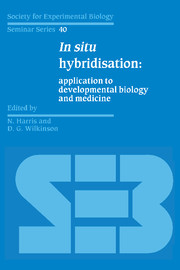Book contents
- Frontmatter
- Contents
- List of contributors
- Preface
- Non-radioisotopic labels for in situ hybridisation histochemistry: a histochemist's view.
- Use of haptenised nucleic acid probes in fluorescent in situ hybridisation
- The use of complementary RNA probes for the identification and localisation of peptide messenger RNA in the diffuse neuroendocrine system
- Contributions of the spatial analysis of gene expression to the study of sea urchin development
- Advantages and limitations of in situ hybridisation as exemplified by the molecular genetic analysis of Drosophila development
- The use of in situ hybridisation to study the localisation of maternal mRNAs during Xenopus oogenesis
- In situ hybridisation in the analysis of genes with potential roles in mouse embryogenesis
- Evolution of algal plastids from eukaryotic endosymbionts
- Localisation of expression of male flower-specific genes from maize by in situ hybridisation
- Tissue preparation techniques for in situ hybridisation studies of storage-protein gene expression during pea seed development
- Investigation of gene expression during plant gametogenesis by in situ hybridisation
- Sexing the human conceptus by in situ hybridisation
- Non-isotopic in situ hybridisation in human pathology
- The demonstration of viral DNA in human tissues by in situ DNA hybridisation
- Index
Preface
Published online by Cambridge University Press: 04 August 2010
- Frontmatter
- Contents
- List of contributors
- Preface
- Non-radioisotopic labels for in situ hybridisation histochemistry: a histochemist's view.
- Use of haptenised nucleic acid probes in fluorescent in situ hybridisation
- The use of complementary RNA probes for the identification and localisation of peptide messenger RNA in the diffuse neuroendocrine system
- Contributions of the spatial analysis of gene expression to the study of sea urchin development
- Advantages and limitations of in situ hybridisation as exemplified by the molecular genetic analysis of Drosophila development
- The use of in situ hybridisation to study the localisation of maternal mRNAs during Xenopus oogenesis
- In situ hybridisation in the analysis of genes with potential roles in mouse embryogenesis
- Evolution of algal plastids from eukaryotic endosymbionts
- Localisation of expression of male flower-specific genes from maize by in situ hybridisation
- Tissue preparation techniques for in situ hybridisation studies of storage-protein gene expression during pea seed development
- Investigation of gene expression during plant gametogenesis by in situ hybridisation
- Sexing the human conceptus by in situ hybridisation
- Non-isotopic in situ hybridisation in human pathology
- The demonstration of viral DNA in human tissues by in situ DNA hybridisation
- Index
Summary
Advances in our understanding of biological mechanisms have frequently been associated with the development of new techniques, and this is certainly true for the method of in situ hybridisation. Although the methods of molecular biology have led to the identification and characterisation of innumerable genes and their mechanisms of regulation, a crucial piece of evidence was lacking in early work: detailed knowledge of the sites of gene expression in tissues. In essence, in situ hybridisation combines histochemistry with molecular biology, and enables the rapid analysis of the distribution of RNA (or DNA) in tissues. This information is proving particularly important in the field of developmental biology, since a fundamental aspect of development is the spatial and temporal expression of genes. The application of in situ hybridisation is leading to a revolution in our understanding of plant and animal development, in particular when the technique is combined with other approaches, for example, genetics. In addition, the sensitivity and specificity of in situ hybridisation has found application in the field of medicine, where it is giving new insights into the functioning of healthy tissues and the diagnosis and study of diseases.
The two-day meeting on ‘In situ hybridisation’, held during the SEB Edinburgh Conference in April, 1989, was the first venture to be sponsored jointly by the SEB and the Royal Microscopical Society; it also received support from DuPont, ICI Seeds and Shell. The sessions brought together workers in the fields of development and medicine, and emphasised practical aspects and variations of the technique, and both the strengths and limitations of its applications.
- Type
- Chapter
- Information
- In Situ HybridisationApplication to Developmental Biology and Medicine, pp. xi - xiiPublisher: Cambridge University PressPrint publication year: 1990



